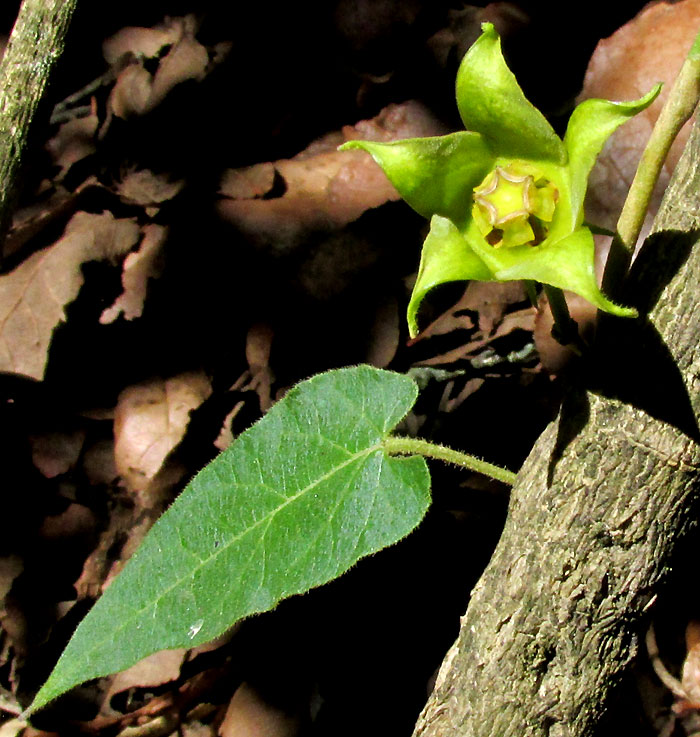Excerpts from Jim Conrad's
Naturalist Newsletter
entry from field notes dated July 2, 2022, taken on Cerro de la Cruz, at an elevation of ~2885m (~9465 ft), just south of the community of El Pinar, Amealco de Bonfil, Querétaro, MÉXICO, (~N20.17°, ~W100.17°)
GONOLOBUS UNIFLORUS

At the mouth of a valley opening toward the east and mantled with oak forest, the above vine wrapped around a dead tree branch fallen onto the forest floor. With heart-shaped leaves on the twining stem arising opposite one another, it was typical of the "climbing milkweeds" of the Milkweed Subfamily Asclepiadaceae, of the Dogbane Family, the Apocynaceae. As climbing milkweed flowers go, this one's flowers were exceptionally large, and the greenish-yellow corollas were noteworthy.

Above, we can see that the leaf is hairy and the big flower, about 37mm across (1-½ inch), though very unlike all flower types outside the Dogbane Family, is typical of the milkweeds.

As with all milkweed flowers, the most distinctive feature is that the male stamens and the female pistil are fused into a single structure, the gynostegium, which in the above image occupies the entire center area. The star-shaped, smooth central part is the stigmatic disc, the female part where pollen grains are supposed to germinate. The rectangular, flap-like things along the gynostegium's sides are anther appendages. The appendages guide pollinator legs into the constriction between the appendages where, at the top, a pollinator leg someday should get snagged on the tiny black thing.
The black things are corpuscula, which form the sharp angle of an otherwise hidden structure formed like an upside-down V, called the pollinarium. At each of the two bottom tips of the upside-down-V-shaped pollinarium are pollinia. Pollinia are waxy masses of pollen, each pollen grain carrying a male sperm. The insect's leg, snagged on the corpusculum, pulls out the whole pollinarium with its two pollinia, maybe to transfer it to the stigmatic disc of another flower, and accomplish pollination.
Beyond all that, it's worth noting that both the interior and exterior of the flower's corolla are hairy.

From the side it's seen how the corolla is somewhat bell-shaped, and the small, slender sepals below the corolla also are hairy.
A hairy, viny milkweed whose flowers produce such conspicuous anther appendages belongs to the genus Gonolobus, of which maybe 150 species are recognized, with about 60 found in Mexico. Gonolobus species are native just to the Americas, from the southern US through South America, and especially diverse in Mexico.
No taxonomic treatment of Gonolobus is available for our region. However, our vine's flowers are so distinctive, and the species isn't very rare within its distribution area, so it was easy to find our plant by doing an image search on the Internet.
It's GONOLOBUS UNIFLORUS, with no English name, occurring in most of upland central Mexico, south to Chiapas. In Spanish sometimes it's called cahuayote, derived from the Náhuatl cuahuitl.